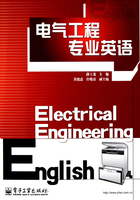
Lesson Four Self-excited A.C.Generators and Their Parallel Operation
It has long been known that self-excited generators were feasible but the practical development of sizes suitable for ship’s generators was delayed until the advent of the silicon semiconductors rectifier. The copper oxide rectifier was not commercial until 1925 and was unsuitable because of its size. The better performance and efficiency of silicon-junction rectifier made the use of self-excited A.C. generators practical and acceptable.
Many of these generators are also compound and therefore come into the category of voltage regulating schemes (called as “functional”). This term means systems of voltage control are operated by measuring or sensing changes in loading condition and maintain the normal voltage by the use components built into the systems. They differ from “error-operated” systems in which a change of voltage takes place and is then restored to normal.
It follows that functional system will generally respond faster than error-operated systems. Nevertheless most functional systems, because of practical difficulties in maintaining normal voltage within very narrow limits, use an automatic voltage regulator (a.v.r.) for trimming purposes. All the methods normally supplied will maintain the A.C. voltage within ±2.5% but some work much closer and 1.5% is attainable with standard equipment.
The systems adopted by manufacturers differ slightly from one another but the following examples demonstrate the general principles in use.
A common principle is the use of terminal A.C. voltage for establishing the no-load voltage and using the load current as a means for providing the extra excitation needed to balance such things as armature reaction and leakage reactance. Where systems differ (and no two systems are alike) is in the trimming necessary to take care of loading conditions, variation of field resistance between cold and hot condition, and power factor.
When paralleling an A.C. generator with other sets already on load the following operations are necessary:
(1) The speed of the incoming machine must be adjusted until its frequency is approximately equal to that of the generator already connected to the bus-bars. Ordinary engine tachometers are not suitable for this purpose.
(2) The voltage must be adjusted with that of the bus-bars.
(3) The paralleling switch must be closed as nearly as possible at the moment when the two instantaneous voltages are in phase.
In practice these operations are just as simple as paralleling two D.C. supplies, but they require a little more patience to get the right conditions, as closing the switch when two supplies are approaching 180°phase difference can have disastrous consequences.
To facilitate the operations a synchroscope is provided. This shows by the speed of rotation of the synchroscope pointer the difference between the two frequencies, and together with the lamps indicates when the voltages are in phase. When the conditions are right the circuit breaker must be closed immediately.
It is preferable that before synchronizing the generator voltage and frequency should be not less than those already on the bus-bar so that the incoming machine immediately assumes a certain load.
The p.f. of a single generator supplying a load is determined by the load impedance but when two or more generators are connected in parallel they forma closed circuit in which power or wattles Kvar can circulate while by passing the load. The p.f. of each machine is therefore not a function of load impedance alone. For a giving driving torque the kVar output of each generator been synchronized and connected to the system, it does not share the load until its speed has been suitably adjusted. Voltage regulation by adjustment of the a.v.r. affects only the distribution of the wattles load.
New Words and Expressions
self-excited [ˈselfikˈsaitid] adj. 自激的,自励的
feasible[ˈfiːzəbl] adj. 可行的,可用的
advent[ˈædvənt] n. 出现,到来
commercial[kəˈməː∫əl] adj. 商品化
silicon[ˈsilikən] n. 硅
semiconductor[ˈsemikənˈdʌktə] n. 半导体
rectifier[ˈrektifaiə] n. 整流器
oxide[ˈɔksaid] n. 氧化物
efficiency[iˈfi∫ənsi] n. 效率,功效,效能
junction[ˈdʒʌŋk∫ən] n. 连接,结合点,结
category[ˈkætigəri] n. 种类,类目
functional[ˈfʌŋk∫ənl] adj. 功能的,函数的
sense [sens] vt. 自动检测
trim [trim] vt. 整理
demonstrate[ˈdemənstreit] vt. 证实,表明
principle[ˈprinsəpl] n. 原则,原理
establish[isˈtæbli∫] vt. 建立
reaction[ri(ː)ˈæk∫ən] n. 反应,感应
variation[ˌvεəriˈei∫ən] n. 变化
incoming[ˈinˌkʌmiŋ] adj. 进来的
tachometer[tæˈkɔmitə] n. 转速计
patience[ˈpei∫əns] n. 耐心,忍耐
approach[əˈprəut∫] v. 接近,探讨
disastrous[diˈzɑːstrəs] adj. 不幸的,灾难的
consequence[ˈkɔnsikwəns] n. 后果,结果
facilitate[fəˈsiliteit] vt. 使(事情)易办,推进
synchroscope[ˈsiŋkrəˌskəup] n. 同步示波器
pointer[ˈpɔintə] n. 指针
circuit-breaker[ˈsəːkitˈbreikə] n. 断路器,开关闸
preferable[ˈprefərəbl] adj. 较可取的
assume[əˈsjuːm] vt. 担任,假定
impedance[imˈpiːdəns] n. 阻抗
circulate[ˈsəːkjuleit] vi. 循环,环流,流通
synchronize [ˈsiŋkrənaiz] vt. 使同步
Notes
(1)The copper oxide rectifier was not commercial until 1925 and was unsuitable because of its size.
这里until是前置词。until在不同情况下可能是前置词或连接词,无论是前置词还是连接词,until的意思都是“直到……为止”,表示谓语所表示的动作或状态,一直持续到until所指的时间才结束。换言之,在until所指的时间来到之前,谓语所表示的动作或状态一直在进行或延续。
例如:
I shall stay here until you come back.
意思是“在你回来之前我将一直留在这里”或“等你回来后我才走”。
这里because of是复合介词,意思是“因为,由于”,后接名词或相当于名词的词。
例如:
Copper is an important conductor, both because of its high conductivity and because of its abundance and cost.
铜是一种重要导体,因为它导电率高,且资源丰富,价格又低。
(2)This term means systems of voltage control are operated …and maintain the normal voltage by…
这里means是及物动词,不是名词,因此不能解释为“手段、方法”,应解释为“意味着”,“s”是第三人称单数形式。“means”后面是一个宾语从句,作mean的宾语。systems前面省略了关联词that,因为that在从句中不作句子的某个成分,只起引导从句的作用,该情况下关联词“that”可省略。
例如:
1)We know (that) a force has direction as well as magnitude.
我们知道,力不仅有大小,而且有方向。
2)We have learned (that) a parallel circuit differs from a series circuit.
我们已知道并联电路不同于串联电路。
(3)The p.f. of a single … but when two or more generators are connected in parallel they forma closed circuit in which power or wattles…
这里but是从属连词,连接两个句子,它前面是一个简单句,后面是一个复合句。when引导的是一个状语从句,in which是定语从句,修饰前面的closed circuit。